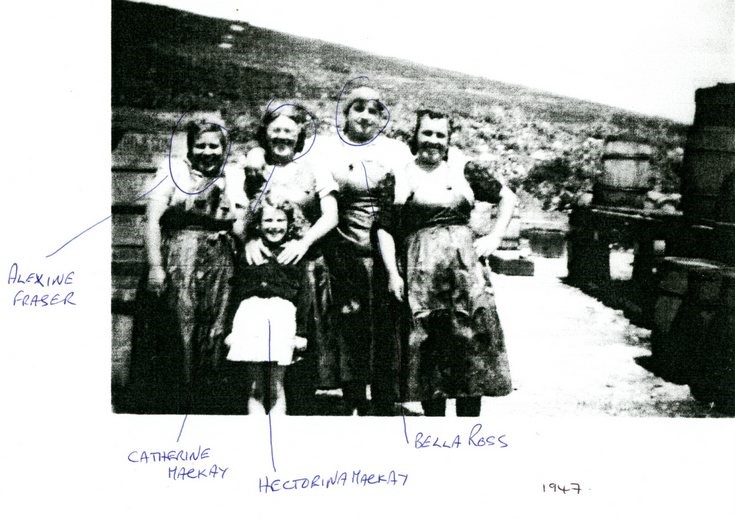
MacKay family photograph 1947
Date Added: 10 November 2015
Year: 1947
Institution Name: dnhhl
Cat No: ◀ | 2015_034_01 | ▶
Picture No: 12268
Monochrome photograph of members of the MacKay family - adults left to right Alexine Fraser, Catherine MacKay, Bella Ross, unknown - child Hectorina MacKay. The barrels in the photograph indicate it was taken when the ladies were employed as fisherfolk.
Dimensions: digital recording
2 Comments
Sorry but I have been unable to get that woman on the extreme left out of my mind and as I began to realise that I knew her. I am now certain that she is Elsie Fraser (Elsie aig Ali) of Terrace Street Embo. She is the mother of Alistair, George and Iris Fraser. Alistair is now in the Edinburgh area and George (Geordie Ruadh) and Iris are still resident in Embo.
Comment left on 18 November 2015 at 18:48 by Kenneth Mackay
Form Goes Here
Immediately after World War 2, many women from Embo formed themselves into 'herring' teams that then went to various herring fishing ports in Scotland and England to gut and pack herring (Gaelic: sgadan) during the 'herring season'. These herrings were packed with large amounts of salt in wooden barrels and were mostly exported. If my memory serves me correctly, I think that each team consisted of two gutters and one packer. The herring ports that I remember being then worked at were Wick, Aberdeen and Peterhead in Scotland and Yarmouth and Lowestoft in England. There may however have been other herring ports involved.
The women in the photo are indeed Alexina Fraser of Gate Street, Embo. Then there is Katherine Mackay with her daughter Hectorina Mackay of Terrace Street, Embo. Katherine Mackay was from the Western Isles and a fluent Gaelic speaker. She was married to my father's brother John Paul Mackay (known in Embo as John P). The next woman is Isabella Ross of King Street, Embo (She was known in Embo as Bella aig Paul as she was the daughter of a Paul Mackay. Paul Mackay was a brother of my paternal grandmother Isabella Mackay who was known in Embo as Bella aig Kenny Main! Isabella the daughter of Kenneth Mackay. Main was one of the several Mackay subgroups in Embo!). The woman on the extreme left I too cannot identify. I suspect that she was from one of the other Gaelic speaking communities on the East coast of Scotland.
Later in the mid nineteen fifties the herring industry failed for a number of reasons, the main one was reported to be that of 'killing the goose that laid the golden egg' over fishing. Another reason for the failure of the industry was that other countries such a Sweden, Denmark, Norway and Russia, which previously were prime customers for British salted herring, now took to harvesting their own herring in the North Sea. At that time, Britain could only claim rights to waters within a 12-mile limit of its shores so could do little to prevent this competition and overfishing. Initially the waters of England were badly fished out and later this problem spread to Scottish waters making the industry unviable.
When the herring industry failed a number of Embo women started to harvest periwinkles (Gaelic: faochag) for selling at the the Billingsgate fish market in London. They did this at low tide on rocky parts of the seashore from the Yards area, south of the village to the old pier on the southern shore of Loch Fleet (then known in Embo as The Little Ferry). Traditionally periwinkles were only harvested in months with an 'r' in their spelling. Sadly, this meant that they were always doing this work at the coldest months of the year. In addition, as their work hours were dictated by the tides it meant they were often working in the very cold early mornings and late evenings.
The periwinkles gathered by these women were then bagged into 50-pound weight lots and labelled. These bags were then taken to the Embo or Skelbo rail stations and from there railed overnight to the Billingsgate fish market in London. Kate Ellen Davidson (nee Cumming), my mother's cousin, of Gate Street, Embo was a tireless periwinkle harvester. She often told that on occasions she was able to leave her harvested bags of periwinkles alongside the train track and that the driver would stop the train to allow them to be loaded on to the train. However, I must admit that her several years of living with her Embo relatives in Florida, in the USA, gave her a charming personality that was hard to say no to!
Sadly, the closing of the Dornoch/Mound railway line in 1962 led however to the death of Embo's periwinkle industry.
My final comment is that Hectorina is my first cousin and I am sure that she was born...sorry Rina...in about 1943. From the photograph, she looks at least seven years old so the date of the photograph must be about 1950.
Comment left on 11 November 2015 at 19:36 by Kenneth Mackay Thanks for another really fascinating comment. Administrator